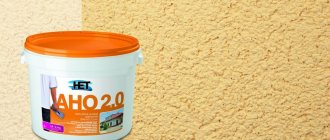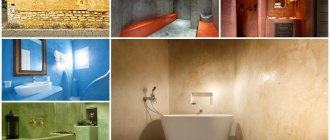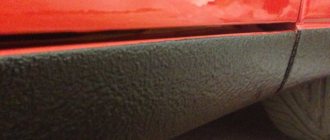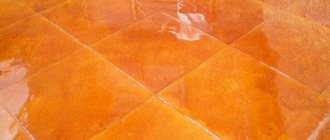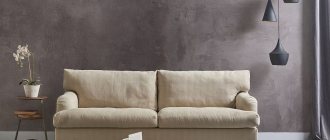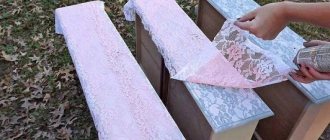What is "Venetian"
Venetian plaster is a decorative mixture used for finishing interior walls. It may include marble, granite, quartz or other natural stone chips, as well as a latex or acrylic binder component.
To achieve an attractive finish that imitates marble, several tones of plaster are used and applied on top of each other. The more layers, the deeper the color will be, and the more expressive the texture will be.
Living room
What could be more expressive in a living room than a stone wall? It's amazing how such a cold and heavy material can be transformed into a warm and inviting feature in a room. No matter what texture and colors you choose, you can pair it with many design styles. This finish will add a rugged, reliable appearance to an elegant, modern living room. It is also the perfect combination for a spacious space with a dining area. A Venetian stone accent wall adds dynamism to a room and is also an ingenious way to hide damaged drywall or plaster surfaces.
Living room in classic style
Combination of plaster and brick
Try combining plaster with different surfaces, such as brickwork, to achieve a loft style in your living room. You can also choose another architectural stone for your interior decor, which comes in a variety of organic shapes, surfaces and shades that will work with almost any interior color palette. Or perhaps you'll discover your living room's ability to emulate historical design with this combination—Art Deco, for example.
Combination with brick
A brick wall partially hidden under a layer of plaster is a splash of texture that can work in a design on its own to create a look and texture unmatched by any other interior wall surface.
What paint is suitable
The material is selected taking into account the microclimate of the room (kitchen, living room, hallway or bathroom) and surface features. Most often latex, acrylic or oil paint is used. Let's briefly talk about them:
Acrylic paint works well
- Acrylic. This is a paint based on water and polymers, giving strength and ductility. Resistant to temperature changes. It is easy to tint and apply. This is one of the best options for the interior.
- Latex. These paints are also water-based and their properties are very similar to acrylic ones. They are odorless and contain no toxins and are vapor permeable.
- Oily. They were popular earlier, but over time they were replaced by water ones. They are quite persistent, but have a pungent odor. When working with them, ventilation of the room is required. To dilute the material and clean the instrument, use solvent or white spirit.
Application of protective coating
Additionally, the plaster can be protected from water, sun and other negative factors by applying a special coating – wax. It is made on a synthetic or natural basis.
Rubber spatulas are used for work. They allow you to apply the thinnest coating and do not scratch the walls. After drying, the plaster is sanded with a machine.
After drying, a finishing wax layer is applied to the base using rubber spatulas.
Beeswax polishing
Beeswax is a natural product. Its use gives the walls a special gloss. The material is applied with a soft rubber spatula in small volumes. It is important to cover all the walls. The wax should be left for half an hour. Then the surface is polished with a grinding machine. It is important that the impregnation does not rub off, but is gently absorbed.
Wax for plaster can be natural or synthetic
Synthetic wax polishing
Polishing with synthetic compounds does not differ in its characteristics from the process with a natural product. Synthetics are used in cases where the result should be matte. It is also necessary to remember that the drying time for synthetic materials is from 10 to 14 days. Only after this period can you wipe and wash the walls.
Photo: colors and interiors
Imitation of Venetian plaster in the interior can have different colors. The following tone options are popular:
Pink
White marble
Malachite
Gray granite
Coatings in blue, green and burgundy shades, complemented by gold patterns, look great. When simulating natural stone, veins of black, ultramarine, and maroon paint are added.
“Venetian” is suitable for baroque, vintage, and classic styles. Depending on the color scheme, you can beautifully decorate the interior of any room - bedroom, living room, bathroom.
In the interior of the kitchen
Living room
Toilet
Bedroom
As you can see, Venetian plaster can have a variety of shades, even if it is an imitation of paint.
Advantages and disadvantages
Venetian belongs to the category of complex coatings.
Not all masters are able to reproduce it. This fact does not reduce its prevalence and frequency of use in finishing. The technique has earned its popularity due to its undeniable advantages:
- environmental safety;
- original effects due to reflection and refraction of sunlight;
- excellent performance characteristics;
- fire resistance;
- varied color palette;
- ease of cleaning;
- resistance to moisture and temperature changes;
- long service life;
- possibility of restoration.
Painting technique with the effect of Venetian plaster
Let's look at how to paint walls with your own hands using different methods of applying regular paint. But first, let’s note the necessary preparation of the surface to be decorated:
- The walls must be level as for painting, i.e. perfectly smooth, without crumbling areas or cracks.
- Be sure to apply a primer; it will remove dust from the surface and improve the adhesion of materials.
Method-1: two colors on a spatula
To work, you will need a plastic or rubber spatula, a wide brush or a lint-free paint roller. You can also use a Venetian trowel as when applying decorative plaster.
Procedure:
- The essence of the work is to create color transitions from dark to light. You need to take two shades of paint on a spatula at once and apply them to the wall with multidirectional movements.
- The borders of the flowers are shaded with a spatula or brush.
- The second layer is made translucent (the amount of color in the paint is reduced). It should lighten or darken areas of Venetian plaster.
- To imitate marble, the finish is supplemented with veins, which are painted with a thin brush.
- After the painted wall has dried, it is covered with protective varnish or decorative wax. It will add moisture resistance and strengthen the finish, and also give the surface the gloss of polished stone and enhance the depth of color.
The result may look like this: painting in two colors + veins
Method-2: marbled stains with a rag
This is also a simple way to imitate the “Venetian”. You will need: a brush/roller for applying paint; a rag to create a marble texture; soft brush for blending color.
Expert opinion
Marina Zanina
Interior designer
First you need to decide on the color. If you want light colors in the finish, then you can simply work on white primed putty. In general, the color of the wall will largely determine the final result, i.e. If you want gray stone, you will have to paint the walls first in a basic gray color.
- The tinted water-based emulsion is applied with a roller or brush to an area of 2-3 m3.
- Soak a rag in water, wring it out well, and keep it crumpled.
- Next, use a rag to make streaks on the fresh paint using wave-like movements. You need to determine in advance which direction the texture of the stone (paint streaks) will go and stick to this direction.
- After the entire painted area has been processed, use a soft brush to shade the waves, making the pattern softer.
- They move to the next section of the wall and work in the same sequence.
- After the paint has dried, you can add a second color to the Venetian plaster, such as gold or silver.
- To complete the decor, cover the walls with glossy acrylic varnish. It will give the paint the effect of polished stone.
In this video, the master paints a Venetian plaster ceiling. The result of this simulation is very realistic.
Decorative plaster
In addition to using real technology, a host of new approaches are being taken to imitate the famous finish with cheap materials, but without sacrificing quality and function. This is how decorative plaster was born - a cheaper gypsum analogue of Venetian plaster, which, however, retained its basic properties in terms of functionality and aesthetic appearance.
Just like Venetian, it is applied by hand and dries into a very durable surface that can last quite a long time - until it becomes water damaged, cracked or peeled.
Decorative plaster - a cheaper gypsum analogue of Venetian
This is a fairly flexible material and is suitable for application to brick, stone, semicircular or frame structures. Provides a durable surface that is easy to clean and can be applied to flat or curved walls and ceilings.
You can also apply some effects to it:
- you can get a stencil;
- decorative painting;
- wallpaper;
- or whitewash.
Original finishing option
This variety and the material's adaptability to virtually any size, shape or configuration of a building meant that gypsum plaster was the choice of choice for almost all buildings up until the 1930s and 40s in Europe.
Polished gypsum stone
It is very similar to Marmorino and is created by adding light and dark marble grains, creating spots within the plaster that make this finish stand out from others.
This versatile plaster can be applied in a number of ways, from a smooth, medium sheen to a subtle weathered and faux aged effect, and can also be made into stone work to achieve a truly stylish finish.
Polished gypsum stone
Examples in the interior
Venetian is used to create various style solutions:
- Walls. Suitable for classical, minimalism, baroque and other styles. Used to decorate living rooms, halls, and corridors.
- Ceiling. The composition gives the ceiling an original relief and texture.
- Columns, fireplaces, niches. Plaster is used to place color and texture accents on decorative elements.
Venetian plaster is used for finishing walls, ceilings and individual decorative elements in the interior.
When decorating bedrooms and children's rooms, preference is given to classical technology. In the case of living rooms, choose more saturated or basic colors, experiment with patterns, and prefer rich textures.
In the dining room, the material is combined with antibacterial impregnation, which will reliably protect the walls from fungus and mold. In the corridor or hallway, the decoration adds expressive tints, highlights, and matte touches.
No less interesting is the Venetian design of balconies, toilets and bathrooms. The designer’s task is to choose the right color scheme and technique.
Correctly selected Venetian plaster makes a room elegant, delicate or dynamic. It allows you to recreate a stone pattern or create shiny grooves. The peculiarity of the texture directly depends on the experience of the artist, the chosen composition and application technique.
Have you ever applied Venetian plaster? What technique did you use? Share your life hacks in the comments.
How to repaint it a different color
Often, in order to match the designers' ideas, the paste must have a different shade from white. A number of manufacturers already produce tinted compounds, but they do not always meet the requirements. Painting paste allows you to create the desired color. To do this, use a color that is suitable in composition. They are sold in construction stores.
Color is added to the mass in a clearly defined proportion. Changing its volume up or down allows you to get different shades of the same color.
The color is added to the decorative plaster and stirred with a construction mixer.
The pigment is introduced directly into the prepared solution. The composition is stirred with a construction mixer or drill for 5 minutes. The entire mass should become homogeneous.
The color of the walls may become lighter after the solution has completely dried.
